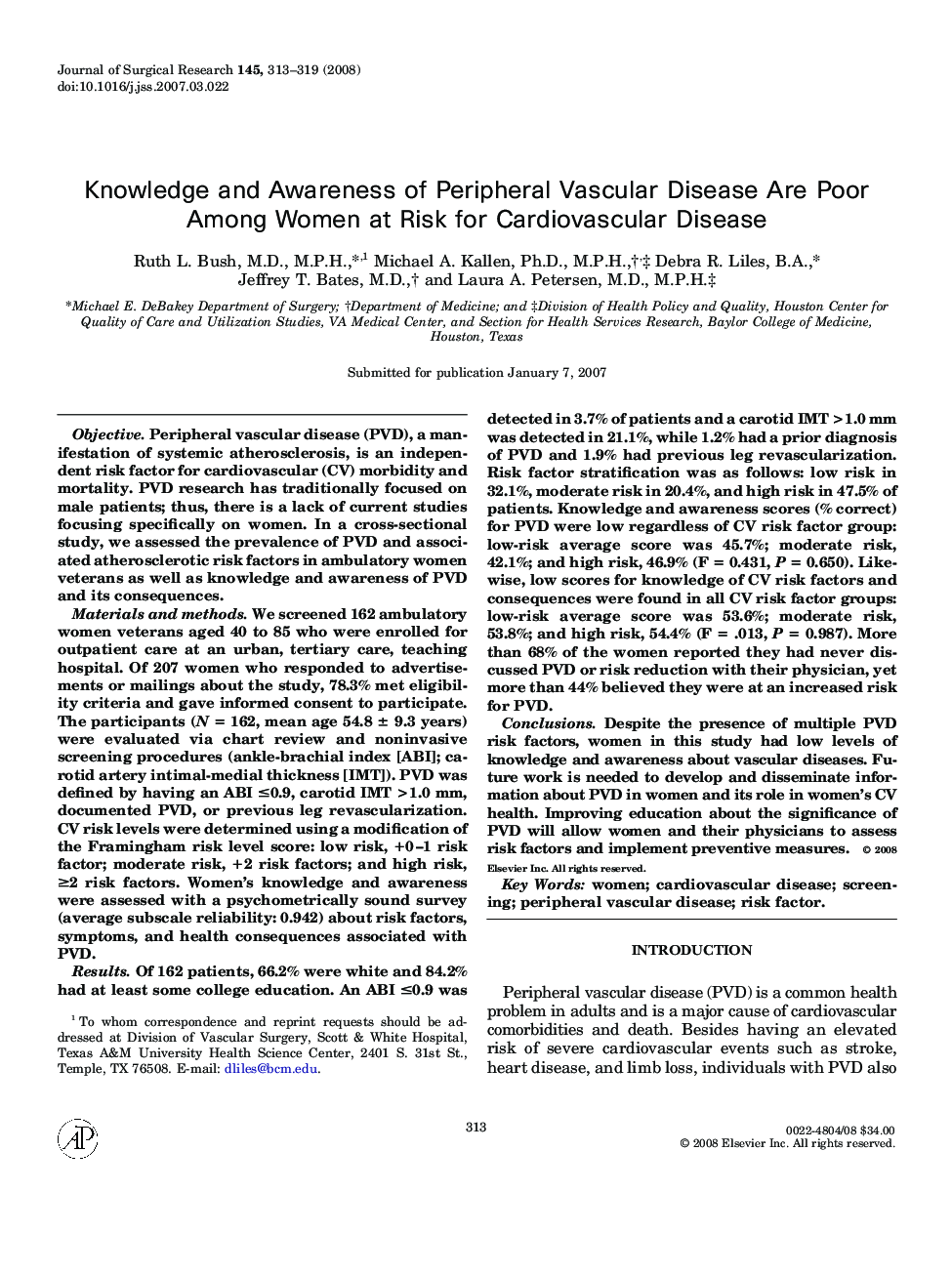| کد مقاله | کد نشریه | سال انتشار | مقاله انگلیسی | نسخه تمام متن |
|---|---|---|---|---|
| 4304182 | 1288498 | 2008 | 7 صفحه PDF | دانلود رایگان |

ObjectivePeripheral vascular disease (PVD), a manifestation of systemic atherosclerosis, is an independent risk factor for cardiovascular (CV) morbidity and mortality. PVD research has traditionally focused on male patients; thus, there is a lack of current studies focusing specifically on women. In a cross-sectional study, we assessed the prevalence of PVD and associated atherosclerotic risk factors in ambulatory women veterans as well as knowledge and awareness of PVD and its consequences.Materials and methodsWe screened 162 ambulatory women veterans aged 40 to 85 who were enrolled for outpatient care at an urban, tertiary care, teaching hospital. Of 207 women who responded to advertisements or mailings about the study, 78.3% met eligibility criteria and gave informed consent to participate. The participants (N = 162, mean age 54.8 ± 9.3 years) were evaluated via chart review and noninvasive screening procedures (ankle-brachial index [ABI]; carotid artery intimal-medial thickness [IMT]). PVD was defined by having an ABI ≤0.9, carotid IMT >1.0 mm, documented PVD, or previous leg revascularization. CV risk levels were determined using a modification of the Framingham risk level score: low risk, +0–1 risk factor; moderate risk, +2 risk factors; and high risk, ≥2 risk factors. Women’s knowledge and awareness were assessed with a psychometrically sound survey (average subscale reliability: 0.942) about risk factors, symptoms, and health consequences associated with PVD.ResultsOf 162 patients, 66.2% were white and 84.2% had at least some college education. An ABI ≤0.9 was detected in 3.7% of patients and a carotid IMT >1.0 mm was detected in 21.1%, while 1.2% had a prior diagnosis of PVD and 1.9% had previous leg revascularization. Risk factor stratification was as follows: low risk in 32.1%, moderate risk in 20.4%, and high risk in 47.5% of patients. Knowledge and awareness scores (% correct) for PVD were low regardless of CV risk factor group: low-risk average score was 45.7%; moderate risk, 42.1%; and high risk, 46.9% (F = 0.431, P = 0.650). Likewise, low scores for knowledge of CV risk factors and consequences were found in all CV risk factor groups: low-risk average score was 53.6%; moderate risk, 53.8%; and high risk, 54.4% (F = .013, P = 0.987). More than 68% of the women reported they had never discussed PVD or risk reduction with their physician, yet more than 44% believed they were at an increased risk for PVD.ConclusionsDespite the presence of multiple PVD risk factors, women in this study had low levels of knowledge and awareness about vascular diseases. Future work is needed to develop and disseminate information about PVD in women and its role in women’s CV health. Improving education about the significance of PVD will allow women and their physicians to assess risk factors and implement preventive measures.
Journal: Journal of Surgical Research - Volume 145, Issue 2, April 2008, Pages 313–319